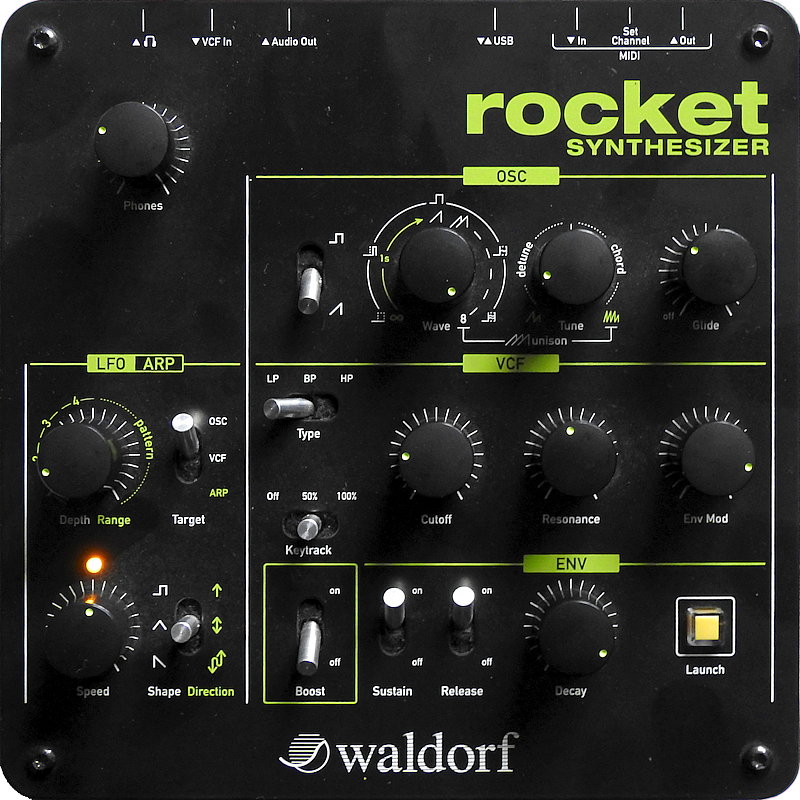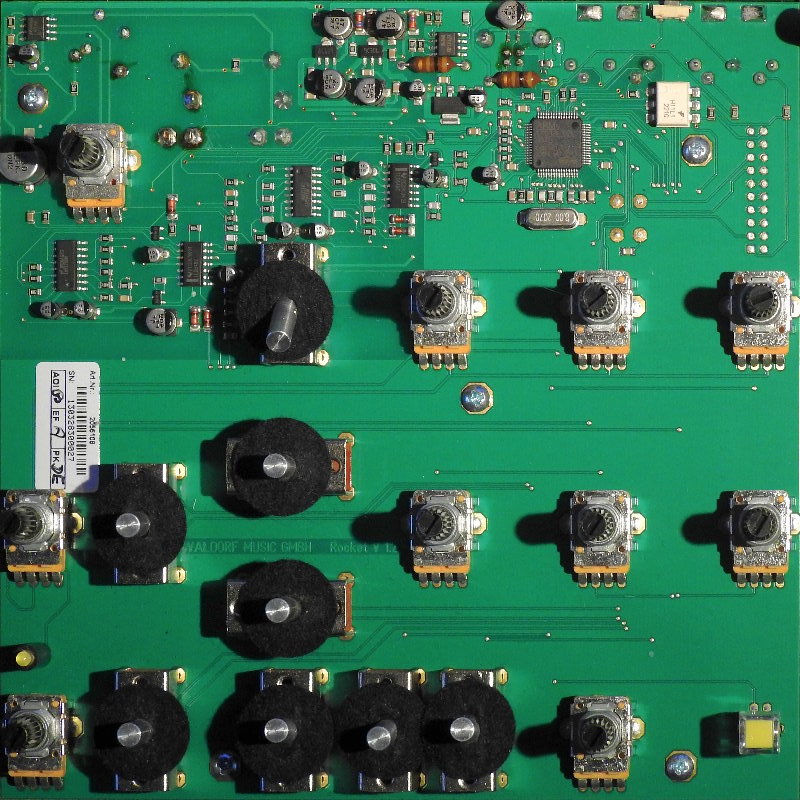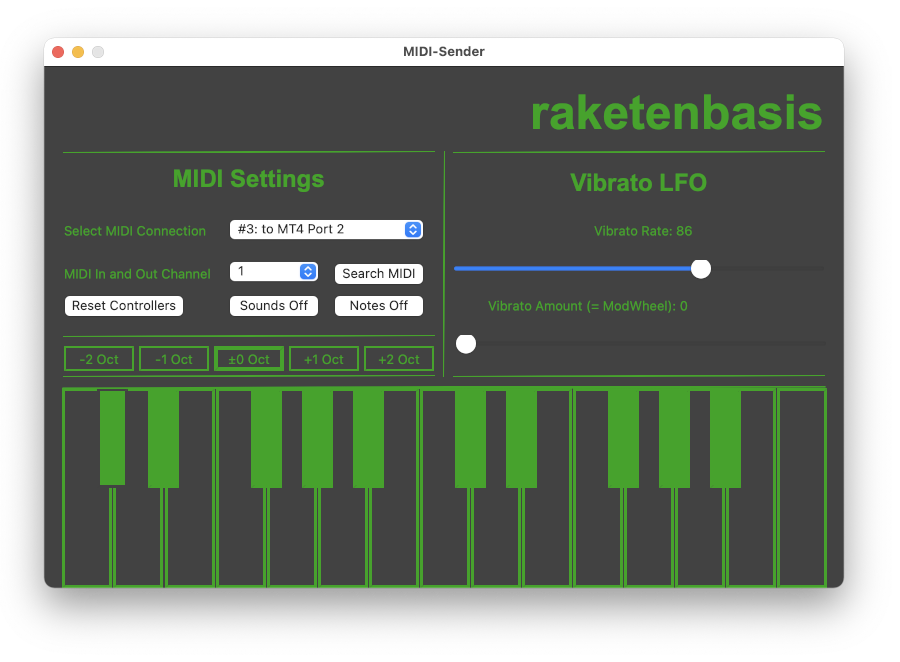Waldorf Rocket

Der kleinste Waldorf Monosynth. Digitaler Oszillator der Supersaw, Pulsewelle mit Pulsweitenmodulation und paraphonische Akkorde bietet. Analoger Multimode Filter (LP, BP, HP). Eine stark minimierte Hüllkurve für VFC und VCA. Ein LFO und Arpeggiator. Ein nicht sichtbarer zweiter LFO nur für Vibrato zur Steuerung mittels des Modulationsrads. Keine Speicherplätze, sendet und empfängt aber MIDI CCs für fast alle Parameter (nur Filter-Modi und Boost nicht).
The most compact Waldorf monophonic synth. Digital oscillator with supersaw, pulse wave with pulsewidth modulation and paraphonic chords. Analog mutimode filter (LP, BP, HP). A very much reduced envelope for VCF and VCA together. One LFO and arpeggiator. A non visible second LFO just for mod wheel controlled vibrato. No patch storage, but sends and receives MIDI CCs for nearly all parameters (except filter mode and Boost).

Innenleben / Inside
- ARM STM32L151 CPU
- 2x LM13700M OTA (Filter & VCA)
- 2x Ti TL064BC Low Power JFET Quad Operational Amplifier (below the PHONES pot and above WAVESHAPE switch)
- LM386 Low Voltage Audio Power Amplifier (for headphone output; top left)
- H11L1 Optocoupler (for MIDI input; the white DIP6 chip)
| Section | Parameter | CC# | alt. CC# | Range |
|---|---|---|---|---|
| General | Phones | not available | ||
| Launch | not available | |||
| Boost | not available | |||
| Mod Wheel | #1 | #1 | 0-127 | |
| Sustain Pedal | #64 | #64 | 0=off, 64=on | |
| All Sounds Off | #120 | #120 | 0 | |
| Reset All Controllers | #121 | #121 | 127, resets Mod Wheel, Sustain Pedal, Aftertouch, Pitch Bend | |
| Local Control | #122 | #122 | 0= off, 127= on | |
| All Notes Off | #123 | #123 | Notes hold by a sustain pedal are not effected | |
| OSC | Waveshape | #31 | #31 | 0=saw, 1=pulse |
| Wave | #70 | #33 | 0-127 | |
| Tune | #79 | #29 | 0-127 | |
| Glide | #5 | #5 | 0-127 | |
| VCF | Filter Type | not available | ||
| Keytrack | #83 | #72 | 0=off, 1=half, 2=full | |
| Cutoff | #74 | #69 | 0-127 | |
| Resonance | #71 | #70 | 0-127 | |
| Env Mod | #73 | #73 | 0-127 | |
| Boost | Boost on/off | not available | ||
| ENV | Sustain | #103 | #103 | 0=off, 1=on |
| Release | #72 | #106 | 0=off, 1=on | |
| Decay | #75 | #102 | 0-127 | |
| LFO | Depth | #77 | #50 | 0-127 |
| Speed | #76 | #16 | 0-127 | |
| Shape | #78 | #15 | 0=saw down, 1=tri, 2=pulse | |
| Vibrato Speed | #80 | #18 | 0-127 rem: this is a second, not visible LFO. Amount controlled only by Mod Wheel | |
| LFO / ARP | Target | #18 | #80 | 0= arp, 1= cutoff, 2= pitch |
| ARP | Range | #12 | #12 | 0-127 |
| Speed/Tempo | #14 | #14 | 0-127 | |
| Direction | #13 | #14 | 0= random, 1= alt, 2= up | |
Zum Stimmen des Filters sendet man das Status Byte "246"(dezimal)= "F6"(hexadezimal). Bitte vorher die Lautstärke des Kopfhöhrerausgangs und der angeschlossenen Boxen/Mischpult senken. Den Filter auf LP (Lowpass) schalten und Boost ausschalten. Eventuell angeschlossene Kabel am VCF Eingang entfernen. Während des 30 Sekunden dauernden Vorgangs leuchtet der Launch-Taster mit etwa halber Intensität.
Sending the Tune Request status Byte "246"(dec)= "F6"(hex) for filter calibration. Please lower the volume of your speakers, mixer and headphones before and set Boost to off, select the filter type LP and disconnect cables in the VCF input socket. While the about 30 secs of filter calibration takes place, the Launch button will light up in a dimmed mode.
Die SysEx Dokumentation hat mindestens einen Fehler: Die Antwort auf die Universal Device Inquiry liefert die Softwareversion als ASCII-Werte nicht wie in der SysEx Dokumentation beschrieben. Die original hexadezimale Antwort diese Bytes lauten "30 31 30 31" (= "0101") und nicht wie beschrieben "31 2E 30 31" (= "1.01").
Die ZIP-komprimierte Datei Waldorf-Rocket-useful-Sysex-files.zip (44 kb) enthält einige nützliche SysEx Dateien:
Und bitte beachten: Die beiden SysEx Dateien zum Ändern der MIDI Sende- und Empfangskanäle benötigen eine kurze Pause von weniger als eine Sekunde dazwischen. Sonst wird das letzte Kommando nicht ausgeführt.
The SysEx documentation got at least one error: the response of the Universal Device Inquiry returns the software revision in ASCII not like shown in the SysEx documentation. The original hex response for these bytes are "30 31 30 31" (= "0101") and not like documented "31 2E 30 31" (= "1.01").
And please notice: you can't send the MIDI SysEx to change the receive and transmit channel directly one after another. You need to place a second or less in between them.
Nützliche SysEx Daten /Useful SysEx files
The zipped file Waldorf-Rocket-useful-Sysex-files.zip (44 kb) got some useful sysex files:
16 sysex files to set the receiving MIDI channel 1-16. This is stored in the Rocket until changed again.
16 sysex files to set the transmitting MIDI channel 1-16. This is stored in the Rocket until changed again.
2 sysex to select the alternatic CC number scheme or the default one (see the table above for details). This is stored in the Rocket until changed again.
Wenn man diesen Befehl nicht in seiner DAW Automation verwendet, kann man diese Werteübertragung auch auf der Frontplatte des Rockets durch ein längere Drücken des Launch-Tasters starten.
The sysex file "Waldorf-Rocket-Controller-Dump-Request.syx" will request the current setting of the knobs and switches, except for the phone volume, the VCF filter mode switch and the boost switch setting. All other parameters of the front panel will be transmitted via MIDI CCSs once the Rocket receives this file.
If you not using this request for your DAW automation, you can start the transmission of the data also on the Rocket itself by holding the Launch button for about a second.
The answer to "Waldorf-Rocket-Universal-Device-Inquiry-Request.syx" will give you the firmware revision and the internal serial number of your Rocket.

Mit der kleinen 64-bit Universal MacOS™ App Raketenbasis kann man den zweiten LFO einfach einstellen und testen. Außerdem kann man auch bequem den MIDI Kanal umstellen.
With the help of the little 64-bit Universal MacOS™ app Raketenbasis it is now easy to set the second LFO rate. You can also test it within the app. And it is easy to select the MIDI channel of the Rocket.